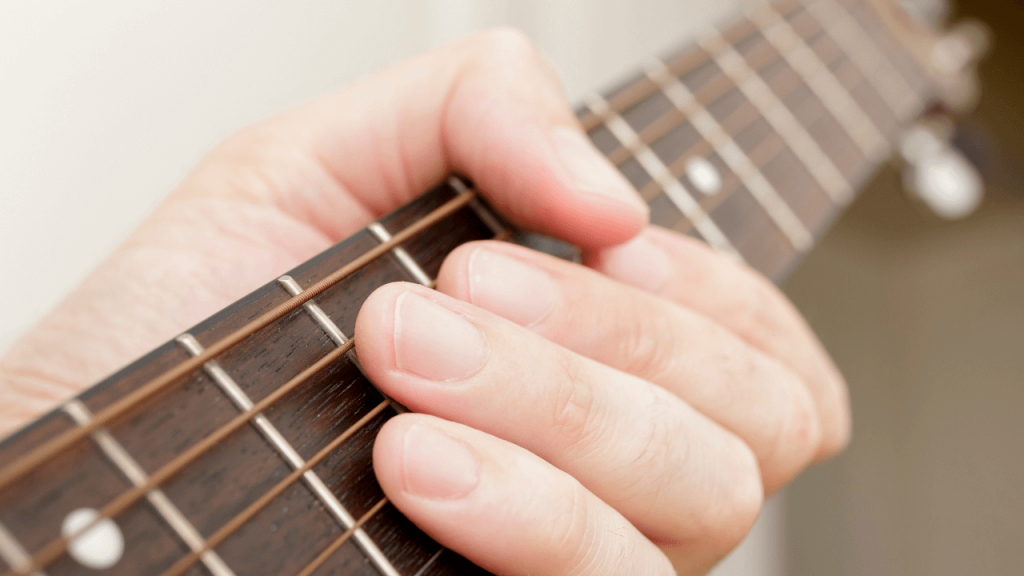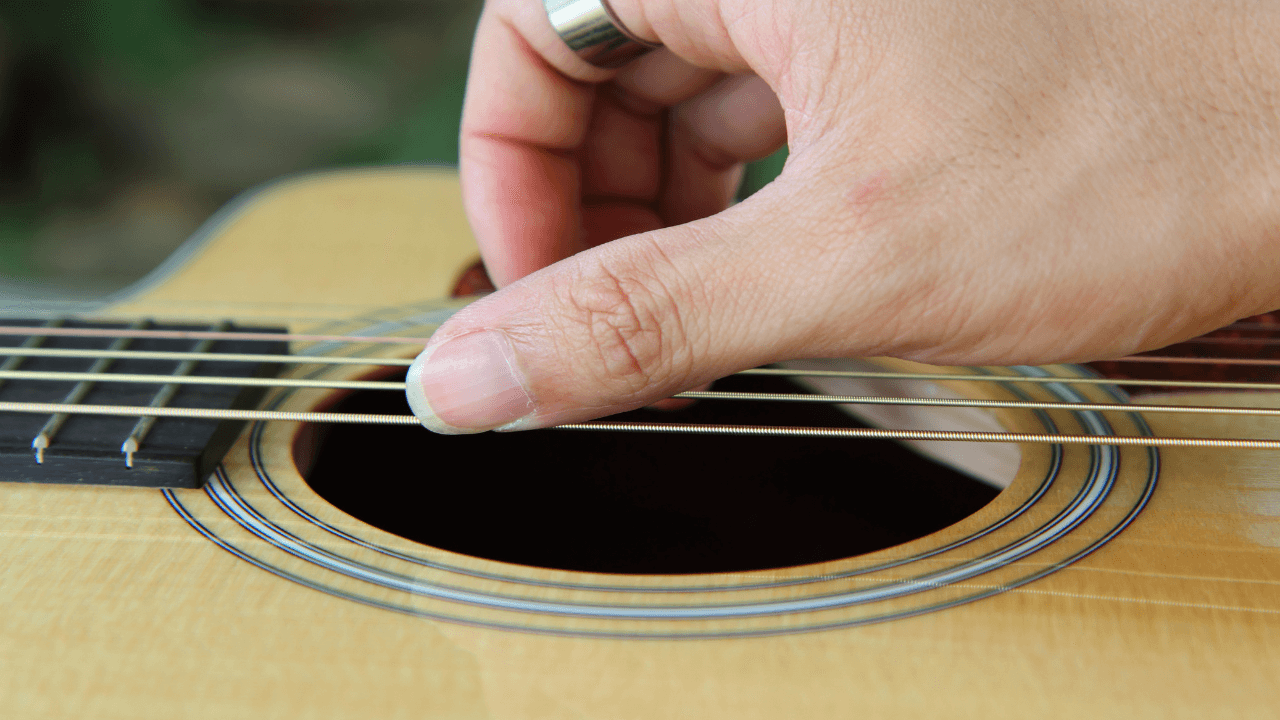Playing the guitar with long nails can be a challenge for many guitarists, but with the right techniques and nail care, it’s possible to maintain your desired nail length and still play the guitar effectively.
In this comprehensive guide, we will explore easy-to-follow steps, tips, and tricks for guitar players with long nails. We’ll address proper finger positioning, playing with the tips of your fingers, overcoming challenges, and maintaining healthy nails without sacrificing length.
Additionally, we’ll discuss specific guitar genres and techniques that benefit from longer nails and how to modify your playing style for those genres.
Can I play guitar with long fingernails?
Yes, it is possible to play the guitar with long fingernails, but it can present some challenges. Playing with long nails may affect your technique and the sound you produce. It’s important to find a balance between maintaining your desired nail length and being able to play comfortably and effectively.
Here are a few considerations to keep in mind:
Technique Modification: You may need to modify your playing technique slightly to accommodate your longer nails. This could involve adjusting your finger positioning, angling your hand differently, or experimenting with different picking styles.
Proper Finger Positioning: Regardless of nail length, proper finger positioning is crucial. Ensure that your fingertips are positioned perpendicular to the strings and just behind the frets. This will help you maintain control and accuracy while minimizing the interference of your nails.
Nail Care and Maintenance: Regular nail care is essential for guitarists with long nails. Trim and shape your nails to prevent snagging and maintain an even length. It’s also important to keep your nails clean and dry to avoid dirt buildup and potential infections.
Experimentation and Adaptation: Every guitarist is unique, and what works for one person may not work for another. It’s important to experiment with different techniques, angles, and nail lengths to find what works best for you.
Adaptation is key to finding a comfortable playing style that allows you to utilize your long nails effectively.
Proper Finger Positioning
When playing the guitar with long nails, it’s crucial to maintain proper finger positioning to avoid hindrance and produce clean, accurate sounds.

Here are some easy steps to follow:
Hand Position: Begin by placing your thumb behind the guitar neck, ensuring a firm and comfortable grip. Maintain a relaxed, yet straight wrist posture.
Finger Placement: Position your fingertips perpendicularly to the guitar strings, pressing them down just behind the frets. This technique allows for better control and minimizes interference from your nails.
Arching Your Fingers: Maintain a slight arch in your fingers to avoid unintentional muting of adjacent strings. This will enable you to produce clear and precise notes.
Playing with the Tips of Your Fingers
Playing with the tips of your fingers is crucial for guitarists with long nails to minimize unwanted string noise and maintain accuracy. Follow these tips for playing with the tips of your fingers:
Shorten the Length of Your Nails: If your nails are excessively long and hindering your playing, consider trimming them slightly. Strike a balance between maintaining your desired nail length and being able to play comfortably.
Adjust Your Angle: Tilt your hand slightly to an angle so that the pads of your fingertips, rather than the nails, make contact with the strings. This will help you achieve cleaner notes and prevent your nails from interfering with your playing.
Challenges and Solutions
Guitarists with long nails may face specific challenges while playing. Here are some common difficulties and their solutions:
String Buzzing: If your nails are causing string buzzing or unwanted vibrations, check your finger positioning and ensure your nails are not touching the strings. Adjust your finger angle if necessary.
Difficulty with Fingerpicking: Longer nails can make fingerpicking techniques challenging. Consider using fingerpicks or thumbpicks to achieve a clear and consistent sound. Experiment with different pick types and find what works best for you.
Strumming Hand Interference: If your strumming hand’s nails are too long, they may interfere with strumming or damping techniques. Trim your strumming hand nails slightly or opt for a thumbpick or fingerpicks to maintain control and precision.
Nail Care for Guitarists
Maintaining healthy and strong nails is essential, even with longer lengths. Here are some tips for nail care:
Proper Hygiene: Keep your nails clean and dry to prevent dirt buildup and fungal infections. Use a gentle nail brush and mild soap to clean them regularly.
Nail Strengthening: Apply a strengthening nail treatment or clear nail hardener to protect your nails from breakage. Regularly moisturize your nails and cuticles with a nourishing oil or cream.
Nail Length Maintenance: Regularly file and shape your nails to prevent snagging and maintain an even length. Avoid using your nails as tools to prevent damage.
Guitar Genres and Techniques Benefiting from Longer Nails
While longer nails may pose challenges, they can also enhance certain guitar genres and techniques. Here are a few examples:
Classical Guitar: Longer nails can produce a fuller, more resonant tone on classical guitars. Maintain a slightly longer length on your right hand nails (for plucking) while following the previous techniques discussed.
Fingerstyle Playing: Fingerstyle guitarists can benefit from longer nails for increased volume and tonal variation. Experiment with different nail lengths and find the sweet spot that works for your playing style.
Flamenco Guitar: Flamenco techniques, such as rasgueado and golpe, can be facilitated by longer nails. Adapt your hand positioning and techniques to maximize control and precision while using your nails effectively.
Can you still play guitar with acrylic nails?
Yes, it is possible to play the guitar with acrylic nails. However, it may require some adjustments to your technique and playing style.

Here are a few considerations when playing guitar with acrylic nails:
Length and Thickness: Acrylic nails are typically thicker than natural nails, which can impact your ability to press down on the strings. You may need to adjust your finger positioning and apply slightly more pressure to produce clean and clear notes.
Technique Modification: The thickness and length of acrylic nails can affect your ability to fret the strings accurately. Experiment with different finger angles and positions to find a comfortable way to press down on the strings without interfering with adjacent strings or causing buzzing sounds.
Tone and Sound: Acrylic nails can produce a slightly different tone compared to natural nails. Some guitarists find that the tone is brighter or more percussive with acrylic nails. Embrace the unique sound and experiment with different playing styles to maximize the potential of your acrylic nails.
Nail Care: Proper nail care is crucial to prevent damage to your acrylic nails and maintain their longevity. Avoid exposing your nails to harsh chemicals or excessive moisture, as they can weaken or loosen the acrylic. Regular maintenance and touch-ups by a professional nail technician will help keep your nails in good shape.
Should guitarists keep their nails short?
The length of a guitarist’s nails is a matter of personal preference and can vary depending on the playing style and genre of music. Some guitarists prefer to keep their nails short for various reasons, while others may choose to maintain longer nails. Here are some factors to consider:
Playing Style: Certain playing styles, such as fingerpicking or classical guitar, often benefit from shorter nails. Short nails allow for more precise and controlled finger movements, reducing the chances of accidentally catching or muting strings.
Technique and Tone: The length of your nails can affect the tone and sound produced on the guitar. Shorter nails tend to create a brighter and crisper tone, which may be desirable for certain genres or playing techniques. However, longer nails can produce a fuller or more resonant tone, which may be preferred in other styles.
Adaptability: Guitarists who frequently switch between playing styles or genres might find it more convenient to maintain shorter nails. Short nails offer greater versatility, as they can adapt well to various techniques without significant adjustments.
Nail Care: Shorter nails are generally easier to maintain and less prone to damage. They are less likely to snag or break during daily activities or while playing the guitar. However, proper nail care is important regardless of nail length to keep them healthy and strong.
Conclusion
Playing the guitar with long nails is indeed possible with the right techniques, finger positioning, and nail care. By following the steps and tips outlined in this guide, you can overcome challenges and enjoy uninterrupted practice sessions.
Remember to maintain proper finger positioning, play with the tips of your fingers, and adjust your technique as needed. With practice and patience, you can master the art of playing the guitar while embracing your longer nails. Happy playing!

